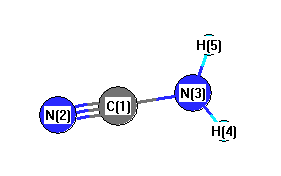Jump to
S1C2
Vibrational Frequencies calculated at HF/CEP-31G
Geometric Data calculated at HF/CEP-31G
Electronic energy levels
Charges, Dipole, Quadrupole and Polarizability
Jump to
S1C1
Energy calculated at HF/CEP-31G
| | hartrees |
|---|
| Energy at 0K | -25.917483 |
| Energy at 298.15K | -25.919746 |
| HF Energy | -25.917483 |
| Nuclear repulsion energy | 31.583763 |
The energy at 298.15K was derived from the energy at 0K
and an integrated heat capacity that used the calculated vibrational frequencies.
Vibrational Frequencies calculated at HF/CEP-31G
| Mode Number |
Symmetry |
Frequency
(cm-1) |
Scaled Frequency
(cm-1) |
IR Intensities
(km mol-1) |
Raman Act
(Å4/u) |
Dep P |
Dep U |
|---|
| 1 |
A1 |
3862 |
3481 |
74.10 |
|
|
|
| 2 |
A1 |
2475 |
2231 |
177.97 |
|
|
|
| 3 |
A1 |
1788 |
1612 |
85.28 |
|
|
|
| 4 |
A1 |
1165 |
1050 |
10.12 |
|
|
|
| 5 |
B1 |
570 |
514 |
41.44 |
|
|
|
| 6 |
B1 |
439 |
395 |
517.96 |
|
|
|
| 7 |
B2 |
4016 |
3620 |
95.77 |
|
|
|
| 8 |
B2 |
1267 |
1142 |
5.04 |
|
|
|
| 9 |
B2 |
449 |
405 |
0.47 |
|
|
|
Unscaled Zero Point Vibrational Energy (zpe) 8015.4 cm
-1
Scaled (by 0.9014) Zero Point Vibrational Energy (zpe) 7225.1 cm
-1
See section
III.C.1 List or set vibrational scaling factors
to change the scale factors used here.
See section
III.C.2
Calculate a vibrational scaling factor for a given set of molecules
to determine the least squares best scaling factor.
Geometric Data calculated at HF/CEP-31G
Point Group is C2v
Cartesians (Å)
| Atom |
x (Å) |
y (Å) |
z (Å) |
|---|
| C1 |
0.000 |
0.000 |
0.226 |
| N2 |
0.000 |
0.000 |
1.391 |
| N3 |
0.000 |
0.000 |
-1.122 |
| H4 |
0.000 |
0.861 |
-1.622 |
| H5 |
0.000 |
-0.861 |
-1.622 |
Atom - Atom Distances (Å)
| |
C1 |
N2 |
N3 |
H4 |
H5 |
| C1 | | 1.1657 | 1.3472 | 2.0386 | 2.0386 |
N2 | 1.1657 | | 2.5130 | 3.1341 | 3.1341 | N3 | 1.3472 | 2.5130 | | 0.9961 | 0.9961 | H4 | 2.0386 | 3.1341 | 0.9961 | | 1.7225 | H5 | 2.0386 | 3.1341 | 0.9961 | 1.7225 | |
 More geometry information
More geometry information
Calculated Bond Angles
| atom1 |
atom2 |
atom3 |
angle |
|
atom1 |
atom2 |
atom3 |
angle |
| C1 |
N3 |
H4 |
120.164 |
|
C1 |
N3 |
H5 |
120.164 |
| N2 |
C1 |
N3 |
180.000 |
|
H4 |
N3 |
H5 |
119.673 |
Electronic energy levels
Charges, Dipole, Quadrupole and Polarizability
Charges from optimized geometry at HF/CEP-31G
Charges (e)
| Number |
Element |
Mulliken |
CHELPG |
AIM |
ESP |
| 1 |
C |
-0.501 |
|
|
|
| 2 |
N |
0.249 |
|
|
|
| 3 |
N |
-0.515 |
|
|
|
| 4 |
H |
0.384 |
|
|
|
| 5 |
H |
0.384 |
|
|
|
Electric dipole moments
Electric dipole components in Debye
(What's a Debye? See section
VII.A.3)
| |
x |
y |
z |
Total |
| |
0.000 |
0.000 |
-5.059 |
5.059 |
| CHELPG |
|
|
|
|
| AIM |
|
|
|
|
| ESP |
|
|
|
|
Electric Quadrupole moment
Quadrupole components in D Å
| Primitive |
|---|
| | x | y | z |
|---|
| x |
-19.065 |
0.000 |
0.000 |
| y |
0.000 |
-14.904 |
0.000 |
| z |
0.000 |
0.000 |
-19.090 |
|
| Traceless |
|---|
| | x | y | z |
|---|
| x |
-2.068 |
0.000 |
0.000 |
| y |
0.000 |
4.174 |
0.000 |
| z |
0.000 |
0.000 |
-2.106 |
|
| Polar |
|---|
| 3z2-r2 | -4.212 |
|---|
| x2-y2 | -4.161 |
|---|
| xy | 0.000 |
|---|
| xz | 0.000 |
|---|
| yz | 0.000 |
|---|
|
Polarizabilities
Components of the polarizability tensor.
Units are
Å
3 (Angstrom cubed)
Change units.
| |
x |
y |
z |
| x |
1.581 |
0.000 |
0.000 |
| y |
0.000 |
2.028 |
0.000 |
| z |
0.000 |
0.000 |
4.608 |
<r2> (average value of r
2) Å
2
| <r2> |
33.966 |
| (<r2>)1/2 |
5.828 |
